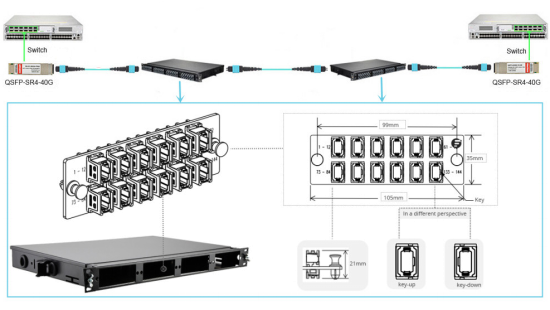November 10, 2016
With the development of Ethernet network, people have much higher requirements for data transmission rate and data capacity than ever before. In order to fulfill these requirements, 40G Ethernet network came into market, followed by a series of 40G fiber optical products, for instance, 40G QSFP+ transceivers, 40G QSFP+ to QSFP+ DAC, 40G MTP Conversion Cables. Among these 40G fiber optical products, 40G QSFP+ transceiver is designed for 40G migration as the most economic and effective module. If you want to upgrade your system into 40G Ethernet network, you may be interested in the information about 40G QSFP+ transceivers and its cabling methods.
In this post, it will talk about one of the basic 40G QSFP+ transceivers, 40G QSFP+ SR4 transceiver and introduce how to connect it to our network. Hence, the 40G migration with 40G QSFP+ SR4 transceiver for building your network can be processed flawlessly and smoothly.
QSFP is the acronym of Quad Small Form-factor Pluggable. From the words, we can easily learn that 40G QSFP+ SR4 is a compact, hot-pluggable transceiver that is being widely used for 40G transmission in short distances. As a 40G transceiver, its function is to connect networking equipment to a fiber optic cable or active or passive electrical copper, allowing 4x10 Gbit/s data rates.
Generally, 40G QSFP+ SR4 is designed to support 40G fiber optic transmission through multimode optical fiber, working on wavelength of 850 nm. It can transmit signals at lengths up to 100 meters through OM3 and 150 meters through OM4. Besides, there are 12-fiber parallel fiber terminated with MPO/MTP multi-fiber female connectors in QSFP+ SR4 to finish 40G transmission, occupying 4 fibers for sending signals, 4 fibers for receiving signals and 4 fibers wasted.
The cabling of QSFP+ SR4 transceiver is much more difficult than of SFP transceiver, which requires more cables and spaces. To better understand the connection method of 40G QSFP+ SR4, the following will introduce several high density QSFP+ SR4 transceiver cabling methods for your reference.
QSFP+ SR4 40G to 40G ApplicationsFrom the following figure, we can learn a simplest way of how 40G to 40G multimode transmission is being achieved by using QSFP+ SR4 transceivers. Two QSFP+ SR4 modules separately inserted in two 40G switches at one end, which are also connected by a length of multimode MTP trunk cable at the other end. Therefore, a 40G to 40G transmission is accomplished by using two QSFP+ SR4 transceivers.

However, when you need lots of 40G connections at the same time and places, the simple cabling method is no longer suitable for cable management. In order to solve this, you are suggested to use a 48-port 1U rack mount MTP fiber patch enclosure, which can deploy up to four 12-port MTP fiber adapter panels for better and higher density cabling as shown in the following figure. Thereby, you can get 40G to 40G transmission with high density.

As we know, QSFP+ SR4 is a 12-fiber parallel optic transceiver which uses four fibers for sending signals and four fibers for receiving signals respectively, with 4 fibers wasted. It has the ability to finish the 40G to 10G transmission by separating the 40G signal into four 10G signals with four fiber optic cables at the 10G distribution end as shown in the following figure. In this transmission, one breakout MTP-8LC harness cable and one 1U 96-fiber enclosure with four HD MTP cassettes are suggested to be applied for better cable management. Besides, four 10G-SR SFP+ modules is also required to inserted in 10G switch/ports, connected to the corresponding LC ports on this fiber enclosure to make the transmission between 10G and 40G.

For higher cabling density, you can also use the 48-port 1U rack mount MTP fiber patch enclosure with an additional MTP-8LC harness cables to finish the 40G to 10G transmission as shown in the following figure. With the help of one 48-port 1U rack mount MTP fiber patch enclosure, the transmission from 40G to 10G can be done easier and managed better.

From this post, you can learn four cabling methods that illustrates how to connect QSFP+ SR4 modules to your network. Except these commonly used ones, QSFP+ SR4 modules can be applied into a variety of application with great flexibility, which depends on practical applications and cabling environments.
Posted by: katherinewangfs at
09:48 AM
| No Comments
| Add Comment
Post contains 742 words, total size 6 kb.
35 queries taking 0.1004 seconds, 65 records returned.
Powered by Minx 1.1.6c-pink.









